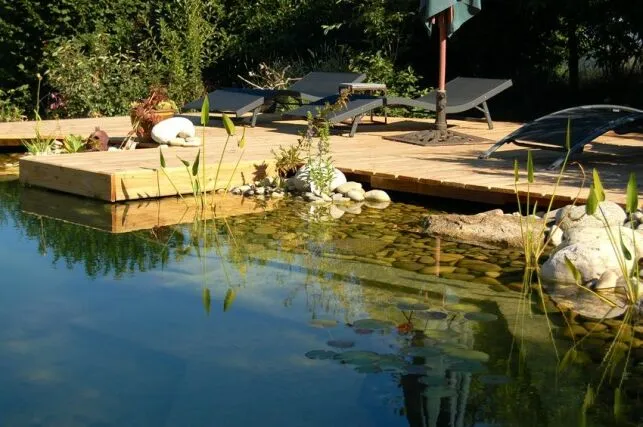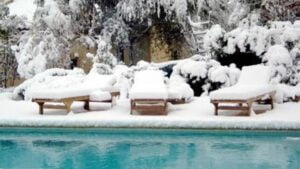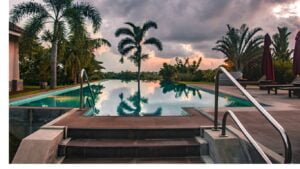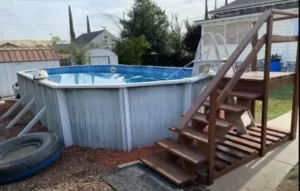Also called an organic swimming pool or a Natural pool, it has the particularity of not using chemicals and a filtration system. How do I create one? What are the advantages and disadvantages of this natural water plan?

How to build a Natural swimming pool photo © Fotolia
Also called an organic swimming pool or a natural basin, it has the particularity of not using chemicals and a filtration system. How to create one ? What are the advantages and disadvantages of this natural water plan ?
Contents
How to create a natural swimming pool?
First, find the right location. Slightly in the shadow, the swimming pool will allow you not to be exposed to the sun all the time and will also have a beneficial impact on aquatic plants in the basin.
It is also necessary to have a fairly large surface area. There is 100 m2 for a swimming area of 20m² on average. In order for the system to function at its best and for the water to be transparent, the area of vegetation must have an area at least equivalent to that of bathing.
From a legal point of view, a prior declaration of work near the town hall is imperative for a basin of more than 10 m2 but less than 100 m2, after checking that this is a buildable area. For ecological pools that are larger than 100 m² and deeper than 2 m, a building permit is necessary.
For the construction, the principle is the same as for a classic pool, above ground in earth, with a concrete structure, cement, etc, taking into account the size of the surface of the lagoon area serving as a natural and ecological filter and then installing a coating such as stones, tiles, etc, liner or EPDM (membrane made of ethylene propylene diene monomer), at the bottom to ensure tightness before covering it with gravel which has the role of helping to get rid of the elements coming from the trees or the garden such as grass after the mowing or the leaves that fall in the fall.
For improved visibility, a small wall around ten centimetres below the water’s surface needs to be sculpted in order to physically and materially identify the separation between the two basins. circulation of water, accompanied by an element allowing a system of mixing water like a pump, brewers, or, more decoratively, a waterfall.
Water thus travels a path in different basins to be filtered via the natural action of plants in order to self-clean up bathing water. To keep the temperature warmer, it is recommended not to dig beyond 2.5 meters in the bathing area.
Ecological and economic tricks
For even more natural water, you can recover rainwater or that of a well.
Which ecosystem should I choose for a Natural swimming pool ?
The natural swimming pool is made up of two or three basins connected to each other by a regeneration space with hydrogen peroxide.
The first basin is used for swimming; the second, shallow, says filtration, lagooning, or planting area » with a flora—floating, purifying and purifying aquatic plants (iris, rushes, water lilies)—and a fauna – insects, bacteria or water snails in particular—playing the role of filter and cleaner and avoiding the appearance of algae and finally a third regeneration zone is needed to oxygenate and aerate the water.
Read Too : How to clear green pool water fast
However, it is possible that the filtration basin and the regeneration basin will be grouped into a single space.
Don’t be surprised to see a frog jump into the pool or a dragonfly take a little dip. A good ecosystem confirms that the basin is in good health.
Watch for water temperature for ecosystem well-being and prevent water from turning if it is too high.
Advantages of a Natural Swimming Pool
First of all, the interview takes less time because water self-regulates. However, it is recommended to launch the automatic robot weekly when it is used to wash the walls and pruning once a year the plants that need it.
As for the problems of allergies, irritation or respiratory tract damage due to chlorine or too high a pH are no arguments to worry about because the water of the pelvis is regulated in a natural and healthy way.
Furthermore, it protects the environment because no chemicals are used for its maintenance. In fact, this does not cause pollution in nature or in pipes.
It gives a more attractive touch to the garden because it combines perfectly with the overall look. All the shapes of the basin are possible, not only rectangular or square as for a conventional model. His presence encourages the coming of birds and other insects in your garden, which will make your plantations even more beautiful and varied.
This installation allows a saving that can represent a certain cost in the long term on the maintenance products not to buy them. And finally, it is not subject to taxation.
Read Too : How to Vacuum an Above Ground Pool
Disadvantages of a Natural swimming pool ?
- Its price. It is higher than that of a classic pool.
- We must find the perfect equation for the choice of plants for an adequate balance for swimming without seeing algae appear.
- The water color It will never be like that of a classic pool, often turquoise blue.
- The total area required is quite large.
- Consumption for water renewal is greater than a conventional swimming pool, due to evaporation.
- The pump used to create a current between the zones works continuously, which increases the electricity bill.
- It is not ideal for chilly weather because water can not exceed 24 °C to prevent the proliferation of bacteria, germs, and/or algae.
- The coming of birds, insects, and other snails who did not previously invite themselves into this landscape can disturb some people.
- Before the first dive, you have to be careful while the aquatic life can develop the expected ecosystem.
- The use of sunscreen can degrade the balance of wildlife, depending on its composition.
Note: The law does not impose a safety system, unlike conventional swimming pool
Frequently Asked Questions- FAQs
Can I use a natural swimming pool year-round?
Yes, natural swimming pools can be used year-round. Proper design, depth, and insulation ensure that the pool remains functional even in colder seasons.
Are natural swimming pools more expensive than traditional ones?
While initial costs may be comparable, natural swimming pools tend to be more cost-effective in the long run due to lower maintenance and reduced chemical expenses.
What aquatic plants are suitable for a natural swimming pool?
Plants like water lilies, cattails, and irises are excellent choices for natural swimming pools, providing both beauty and contributing to water purification
How do I prevent algae in a natural swimming pool
Plants like water lilies, cattails, and irises are excellent choices for natural swimming pools, providing both beauty and contributing to water purification.
Can I build a natural swimming pool myself, or should I hire a professional?
While it’s possible to DIY a natural swimming pool, hiring a professional ensures expertise in design, construction, and ecosystem balance.
Read also –
- Transform Your Backyard Oasis: Hot Tub Privacy Solutions | backyard hot tub privacy ideas
- 10 Tips for choosing your Hot Tub
- How to winterize your pool?
- How to Naturally Clean Your Pool Water
- Detect an Underground Water Main Leak

My name is James A. Bright, and I have worked in the pool and plumbing industries for over 15 years. I started poolprosoutions.com to share my experience with you guys. Here, I provide helpful guides and tips related to pool care, hot tub care, underground water leaks, and pipe leaks.



